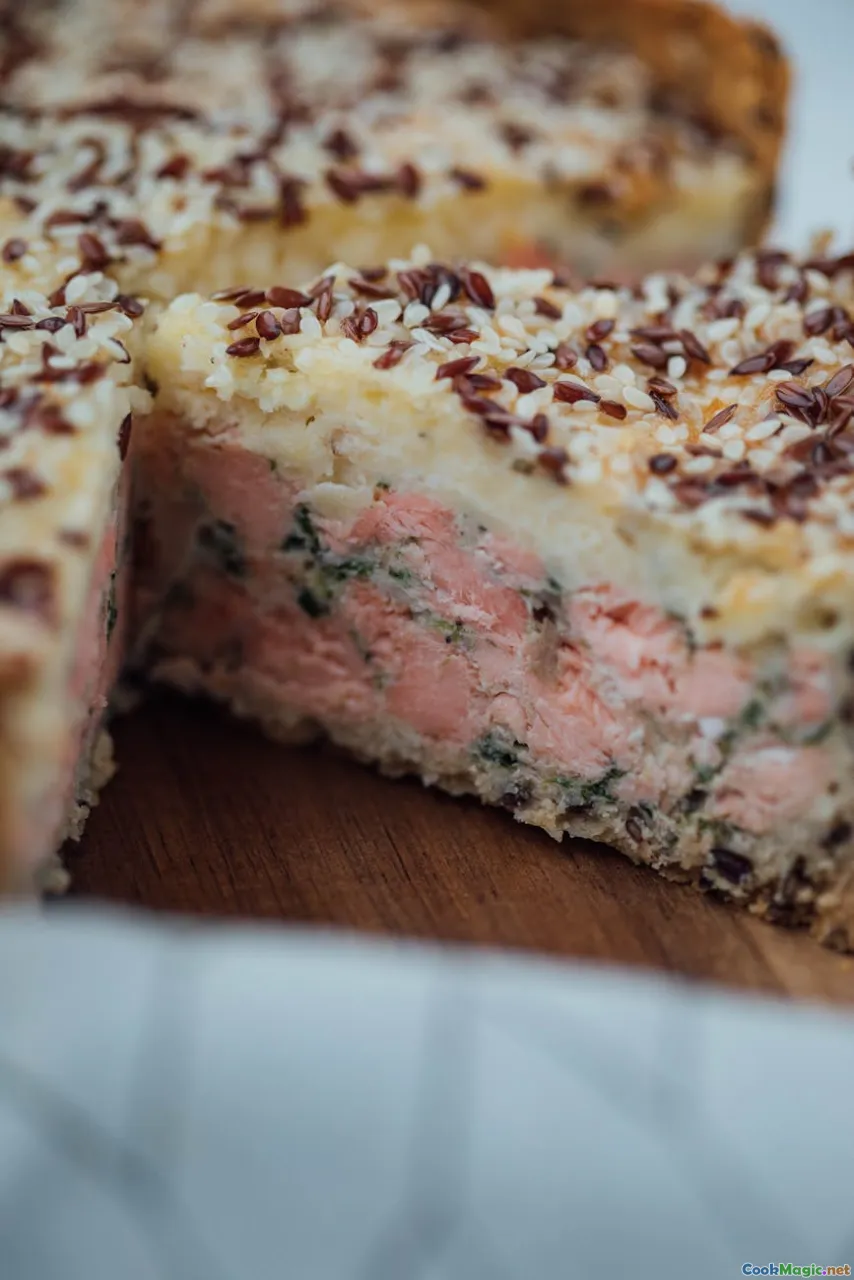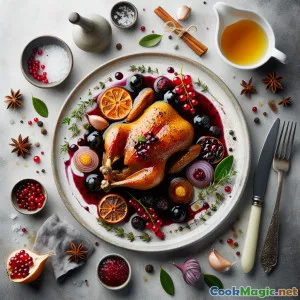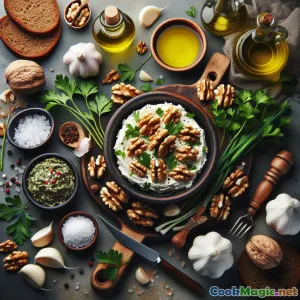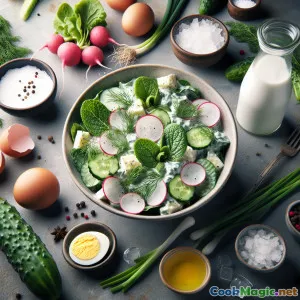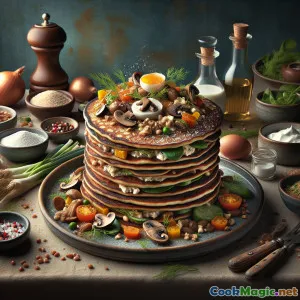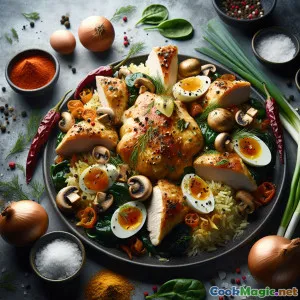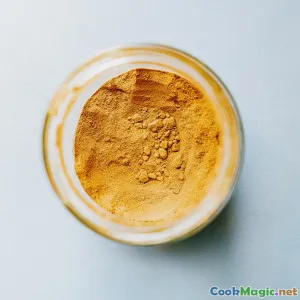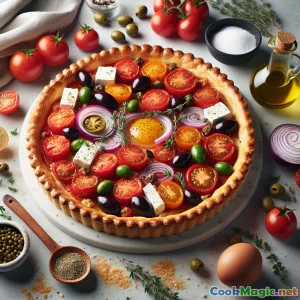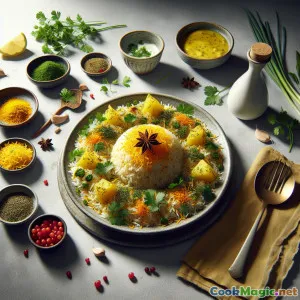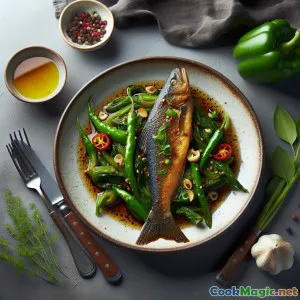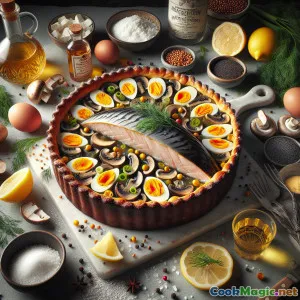
Goldene sibirische Störpastete mit Dillkruste
(Golden Siberian Sturgeon Pie with Dill Crust)
(0 Bewertungen)0
155
Oktober 19, 2025
Problem melden
Zutaten
-
600 grams Sibirisches Störfilet, hautlos und grätenfrei
(Sustainably farmed; cut into 2 cm cubes)
-
1.5 tsp Meersalz
(Divided between fish and filling)
-
1 tsp Gemahlener schwarzer Pfeffer
(Frisch gemahlen für das beste Aroma)
-
1 tsp Zitronenschale
(Finely grated from 1 lemon)
-
1 tbsp Wodka
(Adds subtle aroma; omit if preferred)
-
40 grams Ungesalzene Butter
(For sautéing aromatics)
-
1 large Gelbe Zwiebel
(Fein gewürfelt)
-
1 small Lauch
(White and light-green parts only, finely sliced)
-
200 grams Champignons
(Chanterelle or button, chopped)
-
150 grams Gekochte Buchweizenkörner
(Cooled; traditional Siberian touch)
-
20 grams Frischer Dill
(Fein gehackt)
-
150 grams Saure Sahne (20% Fett)
(For a creamy filling)
-
3 large Hartgekochte Eier
(Geschält und gehackt)
-
2 tbsp Kapern
(Drained and chopped)
-
1 tbsp Scharfer Senf
(Russian-style or Dijon)
-
400 grams Weißmehl
(Gesiebt)
-
200 grams Kaltes ungesalzene Butter
(Cut into 1 cm cubes for dough)
-
120 grams Saure Sahne (für Teig)
(Adds tenderness)
-
1 large Ei (für Teig)
(Leicht geschlagen)
-
30 ml Kaltes Wasser
(Add as needed to bring dough together)
-
1 tsp Feines Salz (für Teig)
(Seasoning for the crust)
-
1 large Eidotter
(zum Bestreichen mit Ei)
-
1 tbsp Milch
(To thin egg wash)
-
1 tbsp Mohnsamen
(For decorative crunch)
-
5 grams Frischer Dill (Garnitur)
(Finely chopped, for serving)
-
1 piece Zitrone
(In Keile schneiden, zum Servieren)
(Sustainably farmed; cut into 2 cm cubes)
(Divided between fish and filling)
(Frisch gemahlen für das beste Aroma)
(Finely grated from 1 lemon)
(Adds subtle aroma; omit if preferred)
(For sautéing aromatics)
(Fein gewürfelt)
(White and light-green parts only, finely sliced)
(Chanterelle or button, chopped)
(Cooled; traditional Siberian touch)
(Fein gehackt)
(For a creamy filling)
(Geschält und gehackt)
(Drained and chopped)
(Russian-style or Dijon)
(Gesiebt)
(Cut into 1 cm cubes for dough)
(Adds tenderness)
(Leicht geschlagen)
(Add as needed to bring dough together)
(Seasoning for the crust)
(zum Bestreichen mit Ei)
(To thin egg wash)
(For decorative crunch)
(Finely chopped, for serving)
(In Keile schneiden, zum Servieren)
Nährwerte
- Portionen: 8
- Portionsgröße: 1 slice (180g)
- Calories: 680 kcal
- Carbohydrates: 0 g
- Protein: 24 g
- Fat: 42 g
- Fiber: 4 g
- Sugar: 4 g
- Sodium: 680 mg
- Cholesterol: 160 mg
- Calcium: 120 mg
- Iron: 2.8 mg
Anweisungen
-
1 - Marinate the sturgeon:
Pat the sturgeon dry. Toss with 1 tsp sea salt, black pepper, lemon zest, and vodka (if using). Cover and refrigerate while you prepare the dough and filling.
-
2 - Make the sour-cream crust:
In a large bowl, combine flour and fine salt. Rub in cold butter until a coarse, pea-sized crumb. Stir in sour cream and egg. Add cold water a splash at a time until the dough just comes together.
-
3 - Chill the Dough:
Divide dough into two discs (one slightly larger for the base), wrap, and chill until firm but pliable. This relaxes gluten and ensures flake.
-
4 - Sauté the Aromatics:
Melt butter in a skillet over medium heat. Add onion and leek; cook until translucent. Stir in mushrooms and a pinch of salt; cook until moisture evaporates and edges brown. Cool slightly.
-
5 - Build the Filling:
In a bowl, combine cooled mushroom-onion mix, buckwheat, dill, sour cream, chopped eggs, remaining 1/2 tsp sea salt, and mustard and capers (if using). Fold gently to keep some texture.
-
6 - Heat oven and prepare pan:
Preheat oven to 190°C (375°F). Line a baking sheet with parchment or lightly butter a 23x33 cm pie tin or oval dish.
-
7 - Roll the base:
On a floured surface, roll the larger dough disc to a 3–4 mm thickness. Transfer to the prepared sheet or tin, leaving a 2 cm overhang.
-
8 - Layer the Filling:
Spread half the buckwheat-mushroom mixture over the base. Distribute sturgeon cubes in an even layer. Top with remaining filling, keeping a clean 2 cm border.
-
9 - Seal and decorate:
Roll the second disc to 3–4 mm and lay it on top. Trim excess, then fold and crimp to seal. Use scraps to cut leaves or fish shapes for decoration, if desired.
-
10 - Vent and glaze:
Cut a few small slits on top for steam. Whisk egg yolk with milk (if using) and brush evenly. Sprinkle with poppy seeds.
-
11 - Bake to Golden Perfection:
Bake 50–60 minutes until deep golden and bubbling at the vents. Internal fish temp should reach about 60°C (140°F). Tent with foil if browning too quickly.
-
12 - Rest and Serve:
Cool 10–15 minutes to set layers. Garnish with fresh dill and serve with lemon wedges. Slice into 8 and enjoy warm or room temperature.
Pat the sturgeon dry. Toss with 1 tsp sea salt, black pepper, lemon zest, and vodka (if using). Cover and refrigerate while you prepare the dough and filling.
In a large bowl, combine flour and fine salt. Rub in cold butter until a coarse, pea-sized crumb. Stir in sour cream and egg. Add cold water a splash at a time until the dough just comes together.
Divide dough into two discs (one slightly larger for the base), wrap, and chill until firm but pliable. This relaxes gluten and ensures flake.
Melt butter in a skillet over medium heat. Add onion and leek; cook until translucent. Stir in mushrooms and a pinch of salt; cook until moisture evaporates and edges brown. Cool slightly.
In a bowl, combine cooled mushroom-onion mix, buckwheat, dill, sour cream, chopped eggs, remaining 1/2 tsp sea salt, and mustard and capers (if using). Fold gently to keep some texture.
Preheat oven to 190°C (375°F). Line a baking sheet with parchment or lightly butter a 23x33 cm pie tin or oval dish.
On a floured surface, roll the larger dough disc to a 3–4 mm thickness. Transfer to the prepared sheet or tin, leaving a 2 cm overhang.
Spread half the buckwheat-mushroom mixture over the base. Distribute sturgeon cubes in an even layer. Top with remaining filling, keeping a clean 2 cm border.
Roll the second disc to 3–4 mm and lay it on top. Trim excess, then fold and crimp to seal. Use scraps to cut leaves or fish shapes for decoration, if desired.
Cut a few small slits on top for steam. Whisk egg yolk with milk (if using) and brush evenly. Sprinkle with poppy seeds.
Bake 50–60 minutes until deep golden and bubbling at the vents. Internal fish temp should reach about 60°C (140°F). Tent with foil if browning too quickly.
Cool 10–15 minutes to set layers. Garnish with fresh dill and serve with lemon wedges. Slice into 8 and enjoy warm or room temperature.
Mehr über: Goldene sibirische Störpastete mit Dillkruste
Story, origins, and why this pie matters
Siberian Sturgeon Pie nods to the grand tradition of Russian festive pastries—think kulebyaka and rybnik—where fish, grains, herbs, and mushrooms are bundled inside a golden crust for feasts and winter holidays. Historically, sturgeon was the queen of the Volga and Siberian rivers, prized for its rich yet delicate flesh and celebrated during banquets from merchant homes to imperial tables. Today, wild sturgeon populations are carefully protected; this recipe embraces responsibly farmed Siberian sturgeon (Acipenser baerii), widely available from reputable aquaculture producers. The result is a luxurious, sustainable centerpiece that captures the spirit of Siberia: forest mushrooms, nutty buckwheat, and dill, glowing under a sour-cream enriched crust.
What makes this version unique
- A sour-cream shortcrust: Adding sour cream to the dough yields tenderness and a gentle tang that pairs beautifully with fish and dill.
- Layered filling strategy: Buckwheat and mushroom aromatics cushion the sturgeon, preventing overcooking while soaking up flavorful juices.
- Clean, bright accents: Lemon zest, capers, and a touch of mustard sharpen the richness without overwhelming the fish.
- Texture contrast: The flake of the crust, the succulent sturgeon cubes, and nubbly buckwheat create a satisfying bite in every slice.
Technique tips for success
- Keep it cold: For a flaky crust, ensure butter and liquids are cold and handle the dough minimally. Visible flecks of butter mean more layers.
- Balance the salt: The filling contains naturally savory ingredients; taste the mushroom-buckwheat mixture before adding the fish, adjusting salt with restraint. Capers add salinity, so use them judiciously.
- Mind the moisture: Cook mushrooms until their liquid evaporates and edges caramelize. This concentrates flavor and prevents a soggy base.
- Gentle fish handling: Cut sturgeon into evenly sized cubes so they cook at the same rate. Overmixing can shred the fish; fold it in last.
- Venting is vital: Steam needs an exit. A few neat slits keep the crust crisp and the filling luscious.
- Rest before slicing: A short rest sets the juices, making slices clean and layers distinct.
Ingredient swaps and variations
- Fish alternatives: If sturgeon isn’t available, try salmon, Arctic char, or firm white fish like pike-perch. Adjust seasoning slightly—oily fish may need extra lemon zest.
- Grains: Kasha (buckwheat) is traditional, but cooked barley or rice is serviceable. Keep the cooked grain relatively dry.
- Herbs: Dill is classic. For a woodsy twist, add a pinch of tarragon or parsley alongside dill.
- Mushrooms: Chanterelles scream Siberia, but cremini or button mushrooms are reliable. Rehydrated porcini add depth—just chop and sauté thoroughly.
- Crust choices: Prefer yeasted dough? A brioche-like kulebyaka crust works beautifully; allow time for proofing and bake until deep golden.
Serving and pairing
Serve the pie warm with lemon wedges and a dollop of lightly salted sour cream or smetana. A simple cucumber-dill salad or shredded beet and apple salad cuts the richness. Drink pairings range from chilled vodka and crisp lager to a minerally white wine (Riesling, Albariño) that loves both dill and cream.
Sustainability notes
Always choose responsibly farmed sturgeon from reputable sources—look for certifications or producer transparency. If sustainability is a concern in your area, select a certified alternative fish and keep the structure of the recipe intact.
Make-ahead and storage
- Make-ahead: Dough can be prepared up to 48 hours in advance and refrigerated; fillings can be cooked and cooled a day ahead (add dill just before assembling).
- Freezing: Assemble the pie and freeze unbaked, well-wrapped, for up to 2 months. Bake from frozen at 180–185°C (356–365°F), extending the time 15–20 minutes and tenting as needed.
- Leftovers: Refrigerate slices up to 3 days. Reheat in a 160°C (320°F) oven to re-crisp the crust.
Final thoughts
This Siberian Sturgeon Pie bridges old-world ceremony and modern kitchen practicality. It delivers layered flavors and textures with a nod to heritage, yet it’s adaptable and forgiving. Whether you’re celebrating a winter holiday or composing a memorable Sunday supper, the buttery crust, dill perfume, and tender sturgeon promise a centerpiece that invites stories at the table—of snowy forests, warm ovens, and the simple pleasure of sharing a beautiful pie.

